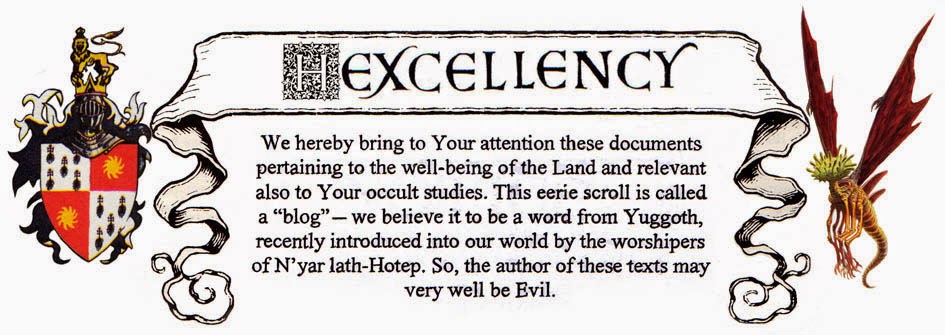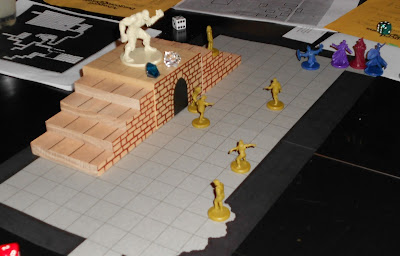When creative types choose to write books
instead of running games, it usually means they’ve encountered a wall –
because, yes, there are a few “walls” in role-playing games. Lack of realism,
is one of them. Lack of emotions, is another. Lack of complexity. Lack of
consistency. Let’s study those dreaded walls, then. Maybe we’ll find a few concealed
doors in ’em, or something.
But first, let’s just take a quick look at
some of the best-known “DM authors”.
Steven Erikson is a shining example: he ran
a very detailed and whimsical campaign for years, and then quit playing, only
to write everything down in a staggering ten-volume, 13,000-page epic.
These books are undoubtedly better than the original campaign, but we’ll never
be able to make a real comparison between the two – only Erikson’s old players
can do that.
Professor Barker is another perfect example,
and he transcended both writing and RPGs because he didn’t switch from one to
the other: he wrote books and ran games simultaneously (well, not simultaneously,
but you know what I mean). His gaming fueled his literary production, and his
writing fed his campaign world – so, in this regard, he may very well be the
most accomplished DM author of all.
Charlie Stross is also a guy who gamed for
years, stopped gaming, and then started writing full-time. His books are a good
read, and some sequences are hilariously similar to genuine RPG fight scenes,
with characters scoring crazy critical successes on totally unimportant rolls,
and critical failures right at the worst possible moment.
It is said that young H.P. Lovecraft himself
used to run a “make-believe” game with some other kids from his neighborhood.
We don’t have much information about that, alas, so we probably won’t ever know
if any Great Old One names / plot hooks were actually invented in an Angell
Street backyard or toolshed while eight or ten young 1905 LARPers scuttled
around looking for Envelope #3 or something.
Gygax wrote novels. Saga of Old City
is the only one I’ve read, but it was so long ago, I don’t remember any detail,
so I can’t comment on it. D&D fueled that novel, though: that’s a given.
There are many more DM authors, and it would
take fifty blog posts to list every one of them.
Wall A: Lack of realism
The example I’m gonna use here isn’t taken
out of a pen-and-paper RPG, but rather out of an MMORPG. I’ve never played EverQuest,
but my friends played a hell of a lot. They told me about that enormous
gigantic dragon with 1 million Hit Points (or maybe it was 500,000) and a “regeneration”
ability to top it off. Like, impossible to kill. But some Guild Masters
started to recruit lots (and I mean lots) of players, arrange them in
various units and platoons, and did the math, basically. Optimal unit was 1
cleric for every 5 fighters. The fighters dealt constant damage to the dragon,
and their cleric was always able to heal them on the spot, so no fighter ever
died. Every warlock managed 12 such units (12 clerics with 5 fighters each, so
60 fighters). Every Guild Master managed 30 warlocks (360 clerics and 1800
fighters). And, lo and behold: all the Guild Masters / warlocks / clerics /
fighters threw everything they had at the dragon, for exactly 11 rounds (or was
it 17?), and if nothing broke down in that complex equation – if they were able
to keep it up for 11 (or 17) straight rounds –, they registered 1 million HP of
damage +9% regeneration margin, and killed that dragon!
Impressive feat. Long live Mensa! But it
is... utterly unrealistic. Plus, a scene like that would be über-boring to read
in novel form. This is how things work in the Matrix, but not in any medieval
universe.
If you read the accounts of the battles of
Crécy and Calais – the first major clashes of the Hundred Years War, you’ll see
what I mean. It’s a humongous mess. Total breakdown in communications. No Bluetooth.
No discipline. Every knight wanting to kill the first enemy Lord. Every
man-at-arms wanting to take as many prisoners as possible, because of the
ransom money. Night is falling. It starts to rain. Earls and dukes try to rally
their knights – to no avail. Soldiers soaked in mud can’t recognize each other:
French soldiers kill other French soldiers; English archers kill other English
archers... It’s a gripping read, yes sir, but don’t expect these troops to
whack any million HP dragon anytime soon!
Wall B: Lack of emotions
I never witnessed any remorse or regret, in
30 years of DMing. I have never seen a PC walk up to another PC or to an NPC
and say: “It is my fault your brother / son / heir didn’t survive. I assume full
responsibility for it. To try and redeem myself, I hereby offer you my sword arm:
make me one of your knights, and I’ll serve you; tell me where to go, and I’ll
go; tell me what to do, and I’ll do it.”
In a novel, that sort of thing can happen.
But in a role-playing game, as I have already said in a previous post, it is
way more interesting to remain some sort of biker gang and roam from
town to town without aim, causing mayhem, and never settle down for good.
In the James Bond 007 RPG, three PCs
had to transport a bomb, but they were careless, and the device got stolen from
them. Two days later, twenty-seven people died in an embassy bombing. They knew
it was the same bomb, but there was almost no reaction. One player said: “Dude,
aggravated.” Another guy laughed. And it was the end of it. I won’t try to put
lipstick on a pig here: RPGs are cold and ruthless, for the most part. Lack of
emotions – that will drive creative DMs towards writing books, sometimes.
Wall C: Lack of complexity
It’s a foregone conclusion: if you stick to
the same party of seven characters, your campaign won’t ever achieve the
complexity of a series of books. The Silmarillion covers millennia of
history across three continents. The Malazan Book of the Fallen has
between 2 and 3 hundred characters, both heroes and villains, some of whom
never ever meet, because the action is scattered across an entire planet, and
many other “realms”. Some DMs still try to attain that kind of universal scope,
but it is a huge workload – such real herculean tasks cannot be sustained in
the long run. Also, players get lost in their 63 pages of campaign notes and
sketches. Who will remember the old art dealer from the first adventure, three
years ago – the one who mentioned having been possessed by a Yithian when he
was younger?
Unless you and your players are all
committed to playing twice a month, every month, don’t aim for too much
complexity: it’ll sabotage your entire game. If you really need both, better
write a complex, enthralling book, and run a straightforward, fun campaign.
Wall D: Lack of consistency
Dedicated readers can devour an entire
trilogy in four days, but even the most dedicated of all players couldn’t play
an entire campaign in just four days. Books are consistent: the tone doesn’t
change drastically around page 315. Campaigns are spread out across months,
years, and in some cases, decades: lots of things will change over such a
lengthy period of time. One of my players was unemployed, single, and living in
a crappy 1-room apartment at the beginning of a campaign; when that campaign
ended, he had a full-time job, a pregnant girlfriend, and was shopping around
for a house. In a previous campaign, another player was a goofy, joyous lad at
the beginning; then his mother passed away, and he became one of the angriest,
most disruptive players you’ve ever met. Mood, spirit, and atmosphere can
change on very short notice, at any moment – your only option is to
adapt. Grim campaigns can derail into parody, trust me... I once ran a 1955 Cthulhu
that veered into comedic Paranoia. I urgently sent in a new “guest” PC
to ask questions, investigate the mess, and hopefully help the other players refocus,
but they just stalled the newcomer, denying the existence of any supernatural
phenomena whatsoever. “It’s all a Jewish conspiracy”, they said (I kid you
not). So, in a strange way, it was quite consistent with the “1955” aspect,
only not with a cult of Yog-Sothoth necromancers plotting the annihilation of
all rival sects!
Guaranteed consistency is possible in
writing, not in gaming. Players can hijack your story and turn it (willingly or
unwillingly) into something else entirely, but characters alone won’t.
Final word
The realism thing is easily fixed. Let your
players get their Mensa on, sure, but at some point, tell them: “You simply don’t
know how much damage the others have inflicted yet; your character doesn’t
understand what ‘damage’ technically means.”
The complexity thing can also be fixed. Have
multiple groups of characters play games in the same world, but maybe they
won’t meet anytime soon. (Of course, you will have to work your butt off: way
more separate adventures to prepare.)
“Encountered a wall” is a misleading
expression, and I apologize. There is no wrong way to go, really. You can give
up RPGs and write books – let’s call this Team Stross. It’s a good team. Or you
can run your games and not write – that is Team Arneson. Also a very good team.
Or you can do both – that’s a rather small team, but we’re out there all right:
don’t count us out!







































